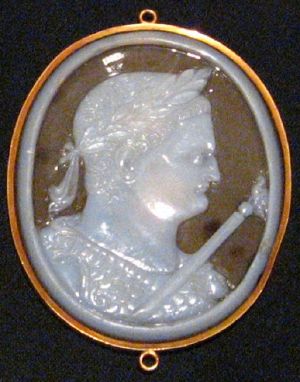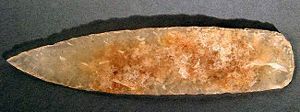Chalcedony
- "Bloodstone" redirects here. For the computer game, see Bloodstone (computer game). For the Marvel Comics characters, see Bloodstone (comics) and Elsa Bloodstone.
Chalcedony is one of the cryptocrystalline varieties of the mineral quartz, having a waxy luster. Chalcedony may be semitransparent or translucent and is usually white to gray, grayish-blue or some shade of brown, sometimes nearly black. Other shades have been given different names. A clear red chalcedony is known as carnelian or sard; a green variety colored by nickel oxide is called chrysoprase. Prase is a dull green and onyx is black and white banded. Plasma is a bright to emerald-green chalcedony that is sometimes found with small spots of jasper resembling blood drops; it has been referred to as blood stone or heliotrope. Flint is also a variety of chalcedony.

People living along the Central Asian trade routes used various forms of chalcedony, including carnelian, to carve intaglios, ring bezels (the upper faceted portion of a gem projecting from the ring setting), and beads that show strong Graeco-Roman influence. Fine examples of first century objects made from chalcedony, possibly Kushan, were found in recent years at Tillya-tepe in north-western Afghanistan. Hot wax would not stick to it so it was often used to make seal impressions.
The term chalcedony is derived from the name of the ancient Greek town Chalkedon in Asia Minor, in modern English usually spelled Chalcedon, today the Kadıköy district of Istanbul.
Geochemistry: Chalcedony
Chalcedony is more soluble than quartz under low-temperature conditions. It is, however, crystallographically identical to quartz. A mineral with the exact same crystallographic and chemical properties should have the same bulk thermodynamic properties (properties which are used to predict solubility). But chalcedony is extremely finely grained (cryptocrystalline), and has a very high surface area to volume ratio. It is believed that this property of chalcedony is responsible for its higher solubility. [citation needed]
Solubility of quartz and chalcedony in pure water
This table gives equilibrium concentrations of total dissolved silicon as calculated by PHREEQC using the llnl.dat database.
| Temperature | Quartz Solubility (mg/L) | Chalcedony Solubility (mg/L) |
|---|---|---|
| 0.01ºC | 0.68 | 1.34 |
| 25.0ºC | 2.64 | 4.92 |
| 50.0ºC | 6.95 | 12.35 |
| 75.0ºC | 14.21 | 24.23 |
| 100.0ºC | 24.59 | 40.44 |
ReferencesISBN links support NWE through referral fees
See also
- List of minerals
External links
- http://www.mindat.org/min-960.html
- http://minerals.usgs.gov/minerals/pubs/commodity/gemstones/sp14-95/chalcedony.html
cs:Chalcedon de:Chalcedon (Mineral) et:Kaltsedon es:Calcedonia fr:Calcédoine lv:Halcedons lt:Chalcedonas ja:玉髄 pl:Chalcedon (minerał) pt:Calcedônia ru:Халцедон sk:Chalcedón sv:Kalcedon tr:Kalsedon uk:Халцедон
